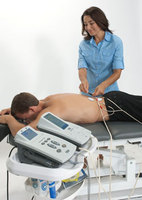 24th Jul 2015
24th Jul 2015
Using Neuromuscular Stimulation in Physical Therapy
One of the coolest parts of working in physical therapy is watching patients regain functional mobility.
Gaining function for patients with neurological injuries can be one of the most rewarding parts of working in pt. With a neurological injury, the muscles of the body must be re-trained and re-educated to function properly. One of the first goals is to rebuild strength in order to perform those typical tasks that people without injuries take for granted. For example when a patient suffers a neurological injury, everyday tasks like walking, can seem intimidating and unattainable. Also, walking “normally” is a common concern for people regaining function after a neurological injury. When treating these patients, the certain modalities are used to help re-train and re-educate the body in the most time-efficient way. One of those devices is neuromuscular stimulation. The use of neuromuscular stimulation can aid in regaining functional mobility and getting patients back to the task of living their lives.
What is Neuromuscular Stimulation (NMES)?
Neuromuscular stimulation is a device that sends a small electric current in order to make your muscles contract. In a healthy person, the nerve carries an electrical message to the muscle telling it to contract. When your nerves are not working normally, as with a neurological injury, the neuromuscular stimulation machine sends the same type of message as your nerve, thus making your muscles contract. The electrical stimulation can increase strength and range of motion, and offset the effects of disuse caused by neurological injuries. The neuromuscular stimulation device can be used during a task, such as walking. For example, “foot drop” is a common problem for people with a neurological injury. Foot drop is when the patient has difficulty picking up his or her toes when walking. This may result in decreased walking speed, decreased step length, and tripping. Using neuromuscular stimulation to the muscles that lift the foot at the correct time during the walking cycle can help the patient to lift and clear the foot when walking. This may result in increased strength of those muscles needed for walking and increased range of motion at the ankle joint. Using a neuromuscular stimulation device in this way can also improve safety, ease, and efficiency with walking while also increasing the patient’s confidence in their body’s ability to relearn tasks.
Neuromuscular Stimulation can Help Stimulate Muscle Contraction
all over the body.
Benefits of Neuromuscular Stimulation
The use of neuromuscular stimulation has many benefits when a patient’s nerves aren’t working properly. The benefits of NMES include:
- Helping to control pain
- Preventing a patient’s muscles from getting tight
- Preventing a patient’s muscles from getting weak
- Decreasing swelling and increasing blood flow to the area
- Helping a patient’s wounds heal
- Increasing a patient’s muscle strength
When a patient suffers a neurological injury, there is a fear of not being able to perform typical activities again. Tools like neuromuscular stimulation not only give a patient hope, but help heal the connection for their body and mind to work together as the team they’re meant to.
For more neuromuscular stimulation therapy products and advice go to ProHealthcareProducts.com







